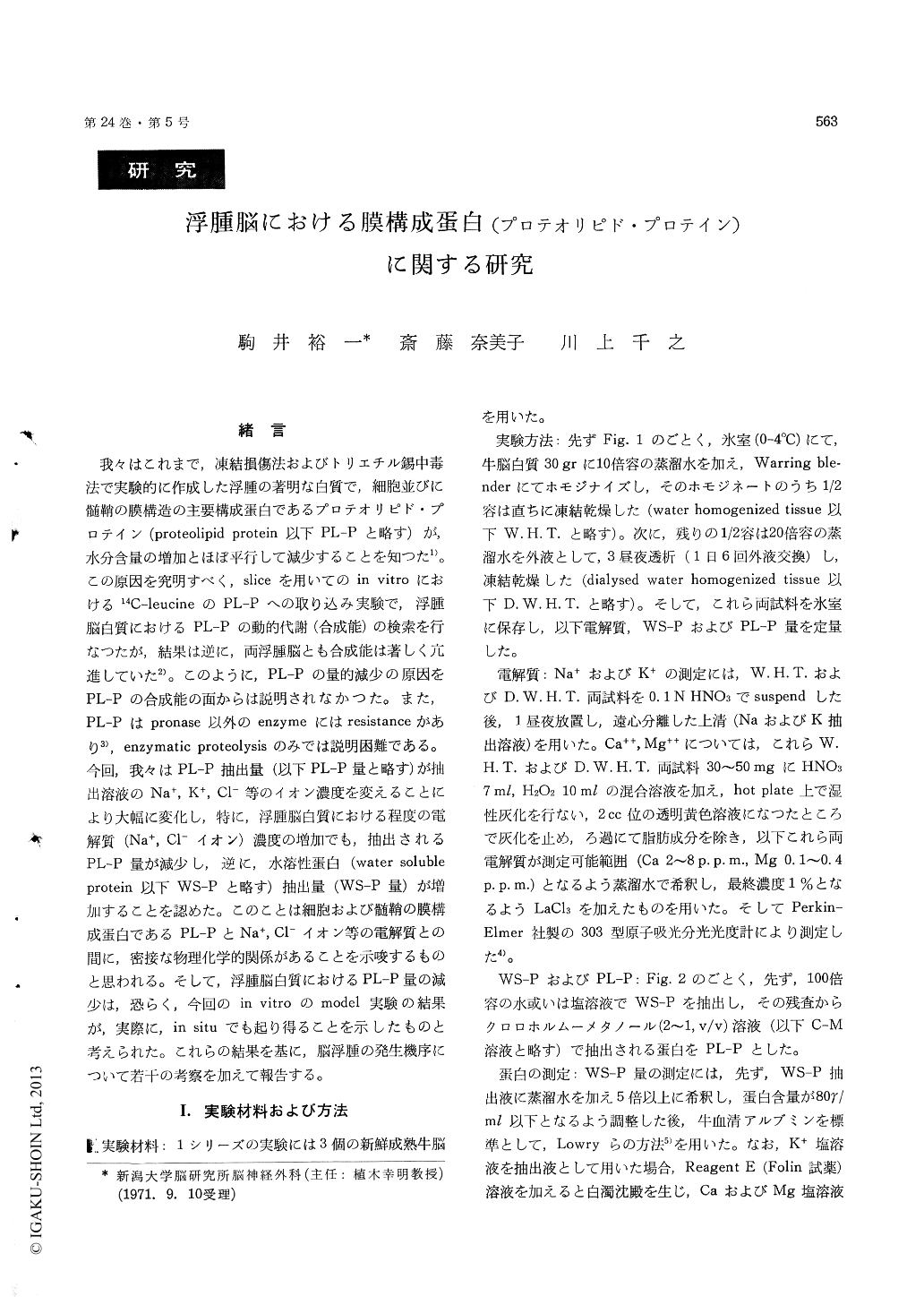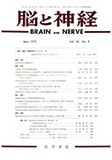Japanese
English
- 有料閲覧
- Abstract 文献概要
- 1ページ目 Look Inside
緒言
我々はこれまで,凍結損傷法およびトリエチル錫中毒法で実験的に作成した浮腫の著明な白質で,細胞並びに髄鞘の膜構造の主要構成蛋白であるプロテオリピド・プロテイン(proteolipid protein以下PL-Pと略す)が,水分含量の増加とほぼ平行して減少することを知つた1)。この原因を究明すべく,sliceを用いてのin vitroにおける14C-leucineのPL-Pへの取り込み実験で,浮腫脳白質におけるPL-Pの動的代謝(合成能)の検索を行なつたが,結果は逆に,両浮腫脳とも合成能は著しく亢進していた2)。このように,PL-Pの量的減少の原因をPL-Pの合成能の面からは説明されなかつた。また,PL-Pはpronase以外のenzymeにはresistanceかあり3),enzymatic proteolysisのみでは説明困難である。今回,我々はPL-P抽出量(以下PL-P量と略す)が抽出溶液のNa+,K+,Cl−等のイオン濃度を変えることにより大幅に変化し,特に,浮腫脳白質における程度の電解質(Na+,Cl−イオン)濃度の増加でも,抽出されるPL-P量が減少し,逆に,水溶性蛋白(water solubleprotein以下WS-Pと略す)抽出量(WS-P量)が増加することを認めた。このことは細胞および髄鞘の膜構成蛋白であるPL-PとNa+,Cl−イオン等の電解質との間に,密接な物理化学的関係があることを示唆するものと思われる。そして,浮腫脳白質におけるPL-P量の減少は,恐らく,今回のin vitroのmodel実験の結果が,実際に,in situでも起り得ることを示したものと考えられた。これらの結果を基に,脳浮腫の発生機序について若干の考察を加えて報告する。
Proteolipid protein (PL-P), most abundant in cerebral white matter, is considered to be a main structural component of myelin sheath and cellular membranes.
In our previous study, PL-P content showed a drastic reduction in white matter of edematous cat brain induced by cold injury and triethyltin into-xication. The reduction revealed a rough propor-tion to increase of water content (Komai, 1969). On the other hand, PL-P syntheses in edematous white matter of cat brains induced similarly showed in vitro a marked increase of incorporation of (U-14C) L-leucine into PL-P by slices. From these experimental results, it might be concluded that the drastic loss of PL-P in the myelin and cellular membranes produced the rapid turnover of PL-P for the repairment of the destroyed membranes (Komai et al., 1971).
There is no evidence what is responsible for the mechanism of the reduction of PL-P content in edematous white matter. PL-P is attacked by pronase but resistant to other enzymes (Tenen-baum et al., 1966). Therefore, the reduction of PL-P content seems not to be explained sufficiently only by enzymatic proteolysis.
In the present experiments, decrease of PL-P and increase of WS-P yield extracted from beef brain white matter, from which freely- and loosely-boundelectrolytes (Na+, K+, Cl- and Mg++ ions, etc) has been removed, are shown as a characteristic shift in quantity of both porteins. These changes of yield of both proteins returned to the former con-dition by adding each electrolyte. Moreover, the changes in solubility of both proteins may be based on their conformational ones resulted from the re-moval of electrolytes.
Parallel experiments were also carried out with different salts (NaCl,Na2SO4; KCl, K2SO4; MgCl2; CaCl2) at various concentrations. Thereby, the less amount of PL-P and the more amount of WS-P yield was found in the higher concentration of other salts except K2SO4. Especially, it may be significant for explanation of mechanism of cerebral edema formation that these changes were made even by the same concentration as electrolyte con-tent (either Na+ or Cl-ion) increased in the edema-tous cerebral white matter.
The present results emphasize a specific inter-relationsqip between the membrane structural pro-teins; PL-P and some electrolytes such as Na+, K+, Cl-, Mg++ and Ca++ ions. They may have the important physiological implication. If they occur in situ virtually, the reduction of PL-P content in vivo reported previously (Komai, 1969) may be in-terpreted as reflecting a change of the inter-rela-tionship in vitro in the present model experiments. For example, alterations in ion concentration and compositions in specific areas of the meylin and cellular membranes may produce the change of membrane structure and its function due to the probable conformational change of PL-P and also the change of the permeability in these parts of the membranes. Such findings may therefore sug-gest the presence of fluid of imbibition in cerebral edema formation.

Copyright © 1972, Igaku-Shoin Ltd. All rights reserved.


